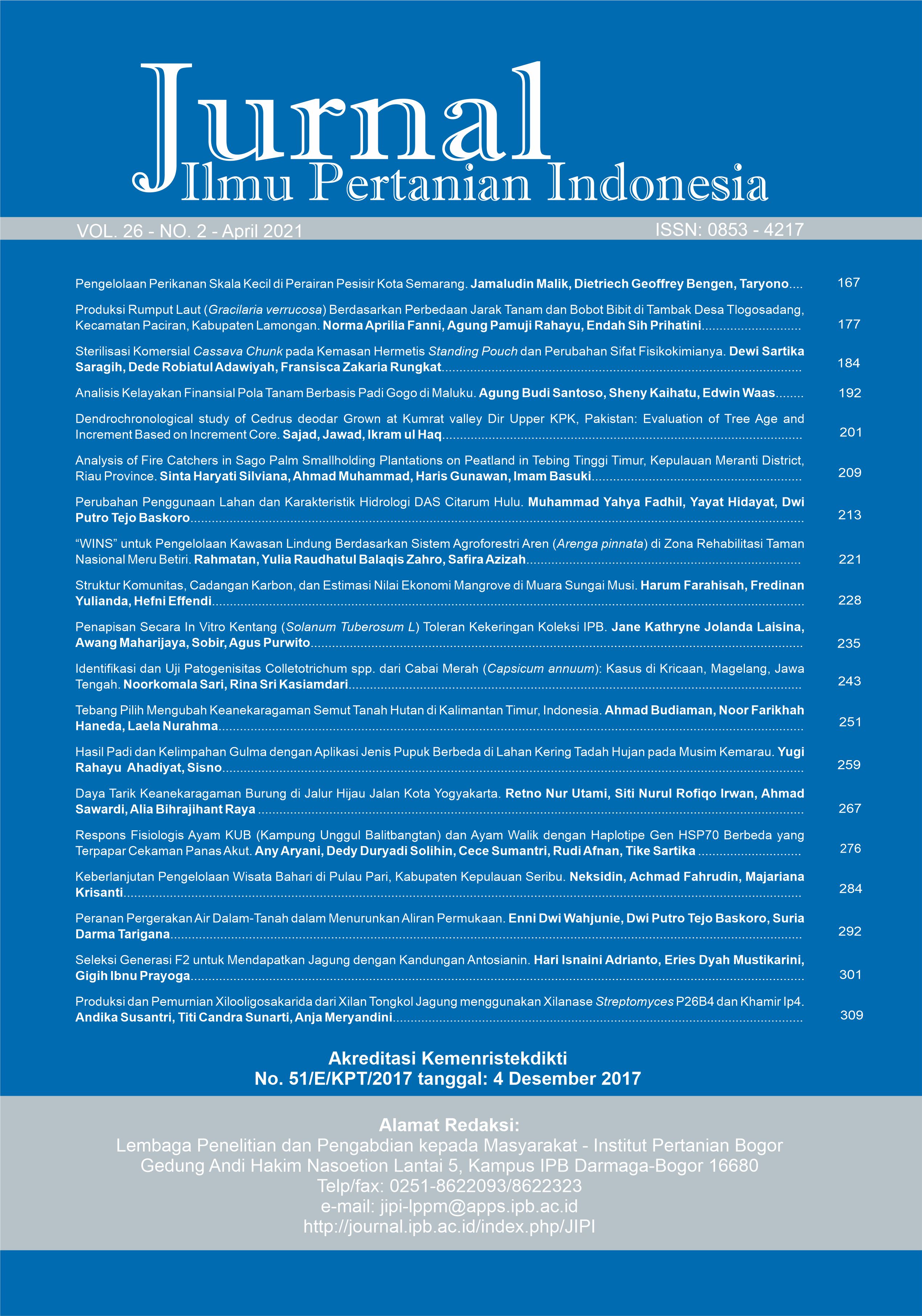Analisis Kelayakan Finansial Pola Tanam Berbasis Padi Gogo di Maluku
Abstract
The upland rice-based cropping pattern is a form of double cropping or crop rotation in which upland rice as a basic commodity (base crop) which can be preceded or alternated with other food crops as a secondary crop. This study was conducted on dry land agro-ecosystems in the Tanimbar Islands Regency (West Southeast Maluku), from March to December 2017. This study was an adaptive research with a field experiment approach in farmer's land. The objective of this research was to obtain the most profitable cropping patterns, efficiency in land use and economically also has the highest net profit so it is appropriate to be recommended as a technology innovation for upland rice-based cropping patterns in dry land. The results showed that upland rice which was cultivated in multiple ways through intercropping or overlapped cropping, namely Introduced Cropping Pattern 1 (Upland Rice + Maize-Peanuts) and Introduced Cropping Pattern 2 (Upland Rice + Corn/Cassava-Green Beans-Peanuts) can increase land productivity (index planting of 222% and 288%, respectively) and farmers' income increased by 244-588% compared to upland rice grown in monoculture. Multiple cropping patterns can be recommended as a technology package for upland rice-based cropping patterns on dry land because of its efficiency in the use of production costs and land use. Furthermore, it gave the highest farm income of IDR63,933,100,-/ha/year with a net profit of IDR45,716,380,-/ha/year or IDR15,238,793,-/ha/ cropping season.
Keywords: cropping pattern, farming, land use, upland rice
Downloads
References
Ali M, Costa DJM, Abedin M, Sayed, N Basak. 2009. Effect of Fertilizer and Variety on The Yield of Sweet Potato. Jurnal Agril 34: 473–480. https://doi.org/ 10.3329/bjar.v34i3.3974
Andrews DJ, Kassam AH. 2015. The Importance of Multiple Cropping in Increasing World Food Supplies. Multiple Cropping. 1–10. https:// doi.org/10.2134/ asaspecpub27.c1
Arraudeau MA. 1995. Upland Rice: Challenges and Opportunities in a Less Favorable Ecosystem. Geo Journal. 35(3): 325–328. https://doi.org/10. 1007/BF00989139
Dalrymple DG. 1971. Survey of Multiple Cropping in Less Developed Nations. Washington: Economic Research Service.
Fitria, Eka, Ali MN. 2014. Kelayakan Usahatani Padi Gogo Dengan Pola Pengelolaan Tanaman Terpadu (PTT) Di Kabupaten Aceh Besar, Provinsi Aceh. Widyariset. 17(3) :425–434.
Hermawati T, Diah. 2016. Kajian Ekonomi Antara Pola Tanam Monokultur dan Tumpangsari. Inovasi XVIII(1): 66–71.
Hidayat, Jan R. 2015. Perluasan Areal Padi Gogo Sebagai Pilihan Untuk Mendukung Ketahanan Pangan Nasional. Iptek Tanaman Pangan. 2(1): 26–40.
Husin M, Toha. 2007. Peningkatan Produktivitas Padi Gogo Melalui Penerapan Pengelolaan Tanaman Terpadu Dengan Introduksi Varietas Unggul. Penelitian Pertanian Tanaman Pangan. 26(3): 180–87.
Idawanni, Hasanuddin, Bakhtiar. 2016. Uji Adaptasi Beberapa Varietas Padi Gogo di Antara Tanaman Kelapa Sawit Muda Di Kabupaten Aceh Timur. Jurnal Floratek. 11(2): 88–95.
Pitaloka, Dyah. 2018. Lahan Kering Dan Pola Tanam Untuk Mempertahankan Kelestarian Alam. Jurnal Teknologi Terapan: G-Tech. 2(1): 119–126. https://doi.org/10.33379/gtech.v2i1.329
Polnaya, Febby, Patty J. 2018. Kajian Pertumbuhan Dan Produksi Varietas Jagung Lokal dan Kacang Hijau Dalam Sistem Tumpangsari. Agrologi. 1(1): 42–51. https://doi.org/10.30598/a.v1i1.297
Prasetyo, Entang I, Hesti P. 2009. Produktivitas Lahan dan NKL Pada Tumpang Sari Jarak Pagar Dengan Tanaman Pangan. Jurnal Akta Agrosia. 12(1): 51–55.
Purwoto, Adreng. 2016. Analisis Usahatani Padi dan Palawija Pada Lahan Kering di Kalimantan Selatan: Studi Kasus di Desa Budi Mulia, Kabupaten Tapin. Forum Penelitian Agro Ekonomi. 7(2): 32. https://doi.org/10.21082/fae.v7n2.1989.32-41
Sasmita, Inggit, Supriyono, Sri N. 2014. Pengaruh Berbagai Varietas Jagung Secara Tumpangsari Additive Series Pada Pertanaman Kacang Tanah Terhadap Pertumbuhan dan Hasil. Journal of Chemical Information and Modeling. 53(9): 1689–1699. https://doi.org/10.20961/carakatani. v29i1.13312
Sasmita, Priatna, Bambang S. Purwoko, and S. Sujiprihati. 2006. Evaluasi Pertumbuhan dan Produksi Padi Gogo Haploid Ganda Toleran Naungan Dalam Sistem Tumpang Sari. Jurnal Agronomi Indonesia. 34(2): 79–86.
Soekartawi. 2002. Analisis Usahatani. Jakarta (ID): UI Press.
Susanto, Noto A, Sirappa MP. 2007. Karakteristik dan Ketersediaan Data Sumber Daya Lahan Pulau-Pulau Kecil Untuk Perencanaan Pembangunan Pertanian di Maluku. Jurnal Litbang Pertania. 26(2): 41–53.
This journal is published under the terms of the Creative Commons Attribution-NonCommercial 4.0 International License. Authors who publish with this journal agree to the following terms: Authors retain copyright and grant the journal right of first publication with the work simultaneously licensed under a Creative Commons Attribution-NonCommercial 4.0 International License. Attribution — You must give appropriate credit, provide a link to the license, and indicate if changes were made. You may do so in any reasonable manner, but not in any way that suggests the licensor endorses you or your use. NonCommercial — You may not use the material for commercial purposes.






















